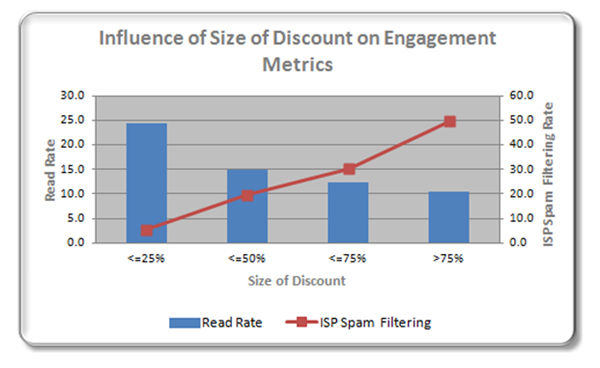Email intelligence is empowering businesses to significantly boost their revenue and beat the competition. But what exactly do I mean by email intelligence? Well, email intelligence is the combination of data from across the email ecosystem, analytics that make it accessible and manageable, and insight that makes it actionable. These components provide critical insight into important subscriber engagement metrics. Not only are marketers able to understand how their subscribers are engaging with their messages, but the icing on the cake is that marketers also gain visibility of how their competitor’s customers are responding. These subscriber metrics include:
- Actual Read Rates
- Emails deleted unread
- Organic forward rates
- Spam notifications
The behaviours that these metrics represent can be positive as well as negative – for example, marking emails that have gone to the junk folder as “Not Spam” or deleting emails only after they have first been read. There is a clearly established correlation between these behaviours, the levels of spam filtering that ISPs apply, and the Read Rates that email campaigns generate.
However, I would imagine a number of readers might still be getting their heads around how to use this data most effectively. To provide a practical illustration, I have collated 30-days of engagement data for seven of the major UK players in the high-volume, ultra-competitive Daily Deals sector.
I am not going to consider the most commonly asked questions in any great depth, other than to say that:
- Optimal subject line length: No real differentiation up to 75 characters which is roughly the point at which subject line truncation generally occurs. Read Rates decline by around a third after that point.
- Best day of week: Wednesdays seem to win – Read Rates are around 12% higher than average on this day, while Spam Filtering rates are around 20% less. Mondays are truly black in the Daily Deals universe: Read rates under-index by 15%, while ISP Spam Filtering rates over-index by 30% on this day!
- Use of the word “Free:” Campaigns with “free” in their subject lines have Read Rates that are 12% higher than those without, and only generate 1/3 of the ISP Spam Filtering, showing that engagement levels are clearly high.
What I am more interested in however, is the way in which subscriber behaviour varies in response to the commercial elements being promoted. In particular, I was interested in using the data to understand the effect of including prices and discounts as part of the offer. This is what I discovered:
- Use of an Explicit “£” or “%” Value in the Offer: Interestingly, email subscribers seem to be ambivalent about offers which are explicit about price of the product or service being offered. Read Rates for campaigns that included a “£” value as part of the offer were near identical to those that don’t.
However, subscribers are clearly suckers for a discount, presumably because this helps them to “visualise” the potential saving that is available, even if the absolute amount is not material. Read Rates for campaigns that include a discount as part of the offer are almost 30% higher than those that don’t.
- Positioning of the Value: Where the value is positioned in the offer turns out to be extremely important. Most people read from left to right, so the start of the subject line is always going to be seen first. Positioning the price or discount at the start of the subject line delivers some remarkable uplifts in subscriber behaviour, as follows:
- Read rates are on average 35% higher.
- Subscribers are 4 times less likely to register a spam complaint.
- They are also twice as likely to re-classify false positives as “Not Spam”
These positive behavioural metrics are reflected in the way that ISPs treat these emails as well. Spam Filtering levels for subject lines that lead with a price or discount value are almost 50% less than those that do not.
- Subscribers aren’t stupid: As an email marketing consultant, I have a long-held belief that subscribers are actually turned off by claims of excessively large discounts. The Inbox Insight data supports this hypothesis as illustrated by the following chart:

It is absolutely clear that there is an inverse relationship between Read Rate and the Size of Discount being promised. Smaller, more realistic, discounts generate higher average Read Rates than is the case for larger, less realistic, discounts. At the same time, ISP Spam Filtering rates are directly related to Size of Discount, with filtering rates of almost 50% being experienced by promotions promising discounts of 75% or more.
Apart from issues with subscriber trust, there are also some practical commercial considerations. If extravagant discounts are a disincentive for subscriber engagement then marketers risk throwing good money after bad. The ability to accurately measure these metrics means that guesswork is replaced by hard facts when it comes to assessing the effectiveness of these offers, and understanding the optimum level of giveaway that maximises the resultant conversion to sale. Ultimately, this intelligence enables marketers to drive better relationships with their subscribers, winning a greater level of return on their Daily Deal campaigns.





